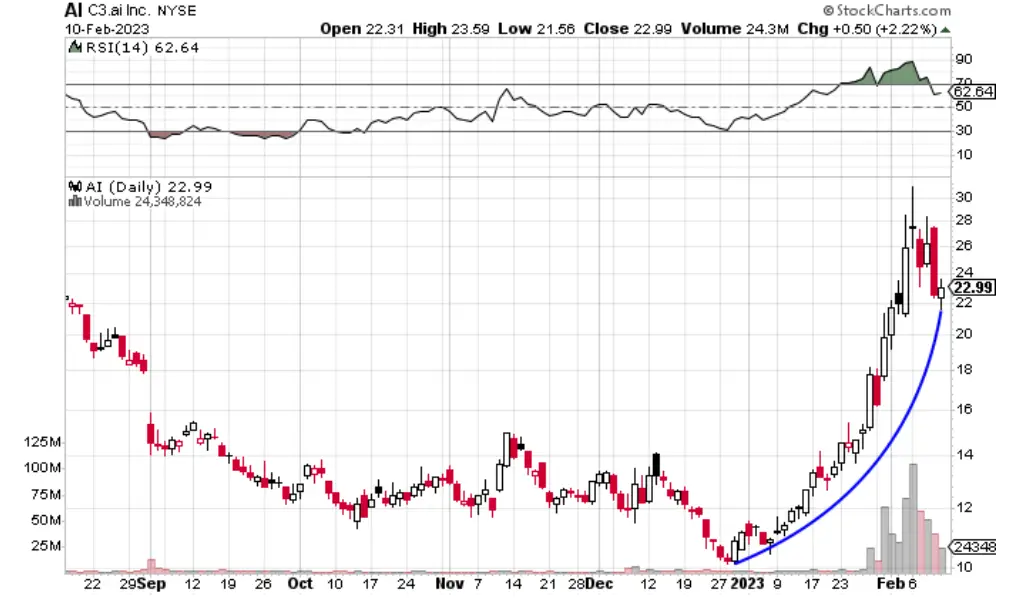The term “parabolic move” came about as part of trader slang describing a price move that goes up at a high rate of velocity and magnitude on a chart. It’s a chart making an upward price move that looks like the right side of a parabolic curve. A parabolic move happens when the speed and upside trajectory of the stock’s price goes up increasing exponentially due to continuous and overwhelming buying pressure.
Parabolic Stocks: Understanding the Phenomenon and Capitalizing on Opportunities
Parabolic stocks are a fascinating and impactful occurrence in the stock market, drawing the attention of traders and investors. These stocks exhibit a remarkable ability to soar at a rapid pace, piquing interest and curiosity. But what exactly are parabolic stocks, and how can you capitalize on them?
What Are Parabolic Stocks?
The perplexing and volatile nature of parabolic stocks has garnered the attention of traders and investors alike. These stocks exhibit a bewildering propensity for price escalation, usually followed by a rapid descent, marked by a steep and persistent upward surge, swiftly transitioning into a sudden and drastic decline. The moniker “parabolic” alludes to the parabolic shape of the price chart.
Parabolic stocks are frequently linked to the momentum of trading, as traders and investors hastily partake in the market, seeking to exploit the swift price increase. Yet, the abrupt and sharp drop that follows can prove equally devastating for those who participated at the peak.
Example of a Parabolic Stocks

The recent runup of C3 AI is an example of a parabolic stock chart move in the shape of a parabola on the right side of the chart and the magnitude of the move. This huge uptrend was created by the bullish sentiment on artificial intelligence that started with Open AIs Chat GPT. Investors and traders were looking for any stock in the AI category to buy into this trend in technology. C3 AI is a leading enterprise AI software provider for building enterprise-scale AI applications and accelerating digital transformation, it benefitted as a publicly traded company in the right industry group.
Why Do Parabolic Stocks Happen?
The formation of parabolic stocks is a complex and mysterious phenomenon, influenced by a multitude of factors. One of the most prevalent causes is a sudden surge of buyers, sparked by a favorable news story or a robust earnings report, which prompts a sudden increase in demand, leading to a self-perpetuating cycle of buying and selling.
Speculation also plays a significant role in the formation of parabolic stocks, as the price escalation of a stock attracts an increasing number of traders and investors, resulting in a bidding war that drives the price even higher. However, this speculation can swiftly transform into panicked selling as the price begins to drop, demonstrating the duality of its influence. Parabolic stock charts can be very volatile on their pathway both up and then down. A parabolic move can go much farther than anyone thought possible becoming stretched far from short-term moving averages and very overbought by technical readings.
How to Capitalize on Parabolic Stocks
Despite the enigmatic and dangerous nature of parabolic stocks, opportunities for traders and investors to exploit this occurrence still exist. The key to success lies in possessing a comprehensive understanding of the underlying factors that drive the price increase, coupled with the readiness to act with swift precision when the opportunity arises.
One approach that has demonstrated effectiveness is to partake in the market early, prior to the rise in price, allowing for the exploitation of momentum while reducing the risk of being caught in a sudden price decline. Another method is the utilization of technical analysis to decipher trends and identify potential breakout levels. By scrutinizing chart patterns with thoroughness, a deeper understanding of the stock’s behavior can be understood, enabling informed decisions on when exactly to buy and sell.
- Buy in early: Get in on the action before the price starts to rise, which allows you to take advantage of the momentum and minimize the risk of getting caught in a sudden price drop.
- Use technical analysis: Use chart patterns and other technical indicators to gain a better understanding of the stock’s behavior and make informed decisions about when to buy and sell.
- Have a solid understanding of the underlying factors: Knowing what is driving the price increase can help you make more informed decisions about when to buy and sell.
- Be prepared to act quickly: Parabolic stocks can move quickly, so it’s important to be prepared to act when the opportunity presents itself.
- Consider using stop-loss orders: Stop-loss orders can help you limit your losses in case the price suddenly drops.
- Consider using a buy order: An automatic order to buy the breakout of a stock from a trading range can allow you to get into a trade very quickly for a big move.
- Take a disciplined approach: Parabolic stocks can be tempting, but it’s important to approach them with discipline and a well-informed strategy in order to maximize your returns and minimize your risks.
Conclusion
Parabolic stocks present a paradoxical opportunity for traders and investors, offering the potential for significant returns, yet requiring a measured and cautious approach. These stocks are marked by a swift escalation in price, followed by an equally rapid decrease, influenced by a multitude of factors, including a sudden influx of buyers, speculation, and favorable news stories.
However, this sudden increase in price is often accompanied by a high degree of volatility, rendering the prediction of the stock’s future direction challenging. This volatility can result in abrupt and sharp drops in price, proving disastrous for those who entered the market at its peak.
To benefit from the potential of parabolic stocks, it’s imperative to possess a comprehensive understanding of the factors driving the price increase, allowing for informed decisions on when to buy and sell, and reducing risk. Complementing this knowledge with a well-informed strategy, such as early participation, technical analysis, and the utilization of stop-loss and trailing stop-orders, can aid in maximizing returns while minimizing risk.
Consult with a financial advisor: Before making any investment decisions, it’s always a good idea to consult with a financial advisor who can provide you with personalized advice and guidance based on your own risk tolerance and return goals.
